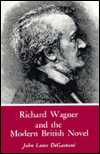

 |

|

The average rating for Richard Wagner and the modern British novel based on 2 reviews is 3 stars.
Review # 1 was written on 2019-12-01 00:00:00 Jochen Lechner Jochen Lechner*** second version *** After an introduction in which he tells the story of how Wagner's works were introduced to England, with particular emphasis on the reaction in the literary world, DiGaetani discusses the work of five authors: Joseph Conrad, D. H. Lawrence, E. M. Forster, Virginia Woolf, and James Joyce. He examines the authors’ relation to Wagner’s work by first taking a biographical look at their experience of Wagner's music and reactions to it. DiGaetani finds all these authors becoming familiar with Wagner during the period of his widespread popularity in England, and Europe generally, in the late Victorian and Edwardian periods, when he was seen as an "advanced" composer who had produced "the music of the future". Conrad had only occasional encounters with Wagner’s works, while Forster and Woolf seem the most dedicated fans, having made the “pilgrimage” to Bayreuth. He then looks at the influence of Wagner’s work on their fiction in 4 ways: 1) Characters who attend Wagner operas, sing or play his music, or discuss the composer, such as Woolf’s Mrs. Dalloway in The Voyage Out. I find that such allusions can be very telling, even in non-fiction. I pretty much knew where Jessie Weston was coming from in From Ritual to Romance when I read the line in her introduction, “During the Bayreuth Festival of 1911 I had frequent opportunities of meeting, and discussion with, Professor von Schroeder”; this was confirmed by het later textual reference to “our Aryan forefathers”. 2) Textual allusions to characters or events in the operas. Lawrence, for instance, has a character named “Siegmund” in The Trespasser. 3) Thematic or plot elements apparently but not explicitly related to the operas, which give the stories a mythical resonance or subtext. An example is the cursed silver mine in Nostromo, a parallel to the cursed gold of the Ring. DiGaetani goes a bit too far here for me, suggesting, for instance, that any tragic love affair that occurs near a body of water and ends in death or attempted suicide is an invocation of Tristan and Isolde. 4) In the case of Forster, the use of verbal leitmotivs to give unity to a work, creating echoes across scenes and emphasizing thematic concerns. Examples given from Howard’s End are Leonard Bast’s umbrella and the concept of “connection”. Though Ulysses has an elaborate web of motiv-like cross-references, DiGaetani is reluctant to attribute this solely to the influence of Wagner, and suggests without giving specifics that it may be due to other influences. Of the various ways in which DiGaetani sees Wagner as influencing these writers, perhaps the most significant is in leading them to use mythology as a subtext. Though DiGaetani limits his discussion of this practice to novels and stories that are underpinned by myths specifically taken from Wagner's works (Tristan, the Ring, Parsifal, and The Flying Dutchman), I found myself wondering whether the use of a mythological substructure, a key feature of modernism (not just in fiction, as the explicit references to Wagner in The Waste Land indicate), might owe its origins to fin de siècle Wagnerism. Certainly it was a fairly common practice in Gothic and other fantastic fiction, and Dickens seems occasionally to use fairy tale elements in his novels, though these seem less likely influences on the moderns than a “musician of the future” like Wagner. *** original review *** DiGaetani discusses the work of five authors: Joseph Conrad, D. H. Lawrence, E. M. Forster, Virginia Woolf, and James Joyce. For each he takes a biographical look at their experience of Wagner's music and reactions to it. He then examines the influence of Wagner's operas on their work in four ways: characters who attend Wagner operas, sing or play his music, or discuss the composer; textual allusions to characters or events in the operas; thematic or plot elements apparently but not explicitly related to the operas; and, in the case of Forster, the use of verbal leitmotivs to give unity to a work. DiGaetani depicts all of these authors as becoming familiar with Wagner during the period of his widespread popularity in England, and Europe generally, in the late Victorian and Edwardian periods, when he was seen as an "advanced" composer who had produced "the music of the future". Of the various ways in which DiGaetani sees Wagner as influencing these writers, perhaps the most significant, though also the hardest to attribute, is in leading them to use mythology as a subtext. DiGaetani limits his discussion of this practice to novels and stories that are underpinned by myths specifically taken from Wagner's works (Tristan, the Ring, Parsifal, and The Flying Dutchman), though one might speculate whether the practice of consciously using mythological subtexts in the realistic novel, a key feature of modernism, in fact developed from an interest in Wagner's works. Authors of Gothic and horror fiction were, of course, already engaging in this practice. |
Review # 2 was written on 2015-02-07 00:00:00 PAUL ROZZI PAUL ROZZIAn excellent overview of series fiction for children. This book lead me to many authors and series which I loved, including Arthur Ransome and .L M Boston. |
CAN'T FIND WHAT YOU'RE LOOKING FOR? CLICK HERE!!!